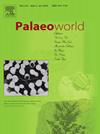Albaillellarian (radiolaria) assemblages across the Guadalupian–Lopingian boundary (Permian) and their environmental implications
IF 1.7
3区 地球科学
Q2 PALEONTOLOGY
引用次数: 0
Abstract
It remains unclear how radiolarian lineages adapted to the changing environments through the Guadalupian–Lopingian boundary (G-LB) interval. In this study, a well-preserved radiolarian fauna was obtained from silty cherts and siltstones deposited throughout the G-LB of the Sanpaoling, Yutouling, and Xiaqianling sections, located in Qinzhou City, Guangxi, China. Two genera of Albaillellaria, including ten species of Albaillella and two Neoalbaillella species/morphotypes, are presented in this study. This assemblage is correlated with the Follicucullus charveti and Albaillella cavitata Interval Zone. Based on the material obtained near the G-LB, the taxonomic value of pores on the test of Albaillella species is here evaluated. This research documents a relatively significant morphological variation of the Albaillellarian lineages and an evolutionary reversal in Albaillella through the G-LB. Based on the combination of the faunal and evolutionary response in the studied area, we suggest that the G-LB witnessed rapidly changing environmental conditions, imposing adaptive pressure on radiolarians, at least on the deep-dwelling Albaillellarians.
瓜达卢佩-洛平边界(二叠纪)Albaillellarian(放射虫)组合及其对环境的影响
目前仍不清楚放射虫系是如何适应瓜达卢佩-珞巴阶界线(G-LB)间的环境变化的。本研究从中国广西钦州市三坡岭、鱼头岭和下前岭剖面的淤泥质碎屑岩和粉砂岩中获得了保存完好的放射虫动物群。本研究展示了两个Albaillellaria属,包括10个种和2个种/变型。该组合与间隔带相关。根据在 G-LB 附近获得的材料,本研究评估了孔隙对物种测试的分类价值。这项研究记录了阿尔贝利尔虫系相对显著的形态变化,以及通过 G-LB 的进化逆转。根据所研究区域的动物和进化反应,我们认为 G-LB 经历了快速变化的环境条件,对放射虫造成了适应压力,至少对深栖的 Albaillellarians 是如此。
本文章由计算机程序翻译,如有差异,请以英文原文为准。
求助全文
约1分钟内获得全文
求助全文
来源期刊

Palaeoworld
PALEONTOLOGY-
CiteScore
4.00
自引率
5.90%
发文量
95
期刊介绍:
Palaeoworld is a peer-reviewed quarterly journal dedicated to the study of past life and its environment. We encourage submission of original manuscripts on all aspects of palaeontology and stratigraphy, comparisons of regional and global data in time and space, and results generated by interdisciplinary investigations in related fields. Some issues will be devoted entirely to a special theme whereas others will be composed of contributed articles. Palaeoworld is dedicated to serving a broad spectrum of geoscientists and palaeobiologists as well as serving as a resource for students in fields as diverse as palaeobiology, evolutionary biology, taxonomy and phylogeny, geobiology, historical geology, and palaeoenvironment.
Palaeoworld publishes original articles in the following areas:
•Phylogeny and taxonomic studies of all fossil groups
•Biostratigraphy, chemostratigraphy, chronostratigraphy
•Palaeoecology, palaeoenvironment and global changes throughout Earth history
•Tempo and mode of biological evolution
•Biological events in Earth history (e.g., extinctions, radiations)
•Ecosystem evolution
•Geobiology and molecular palaeobiology
•Palaeontological and stratigraphic methods
•Interdisciplinary studies focusing on fossils and strata
 求助内容:
求助内容: 应助结果提醒方式:
应助结果提醒方式:


